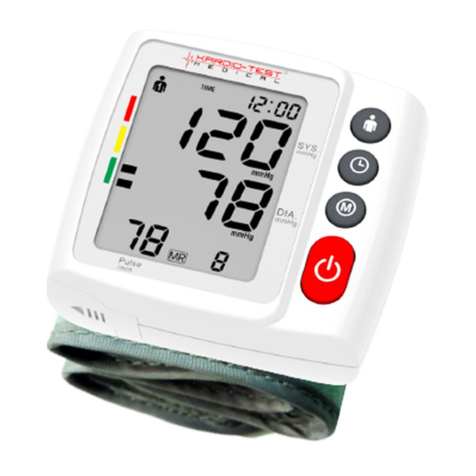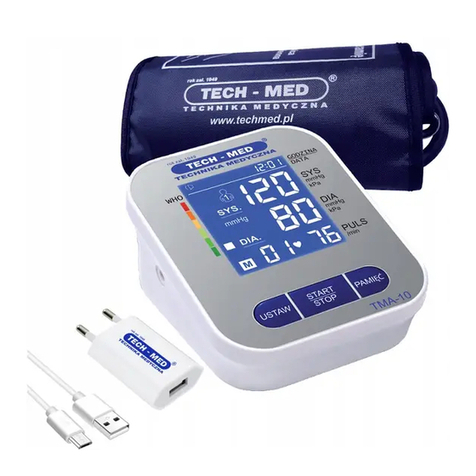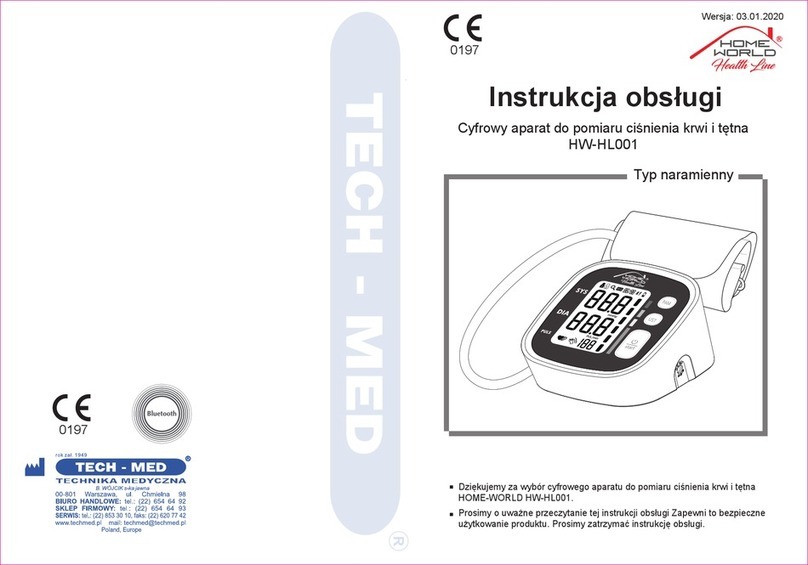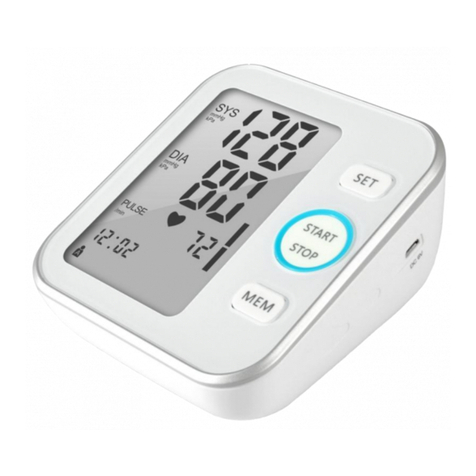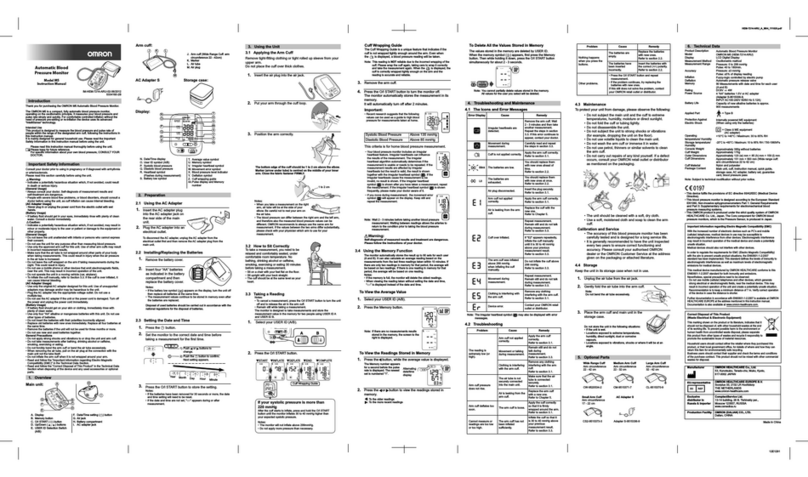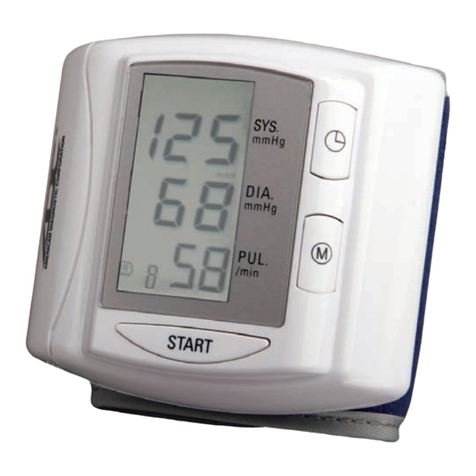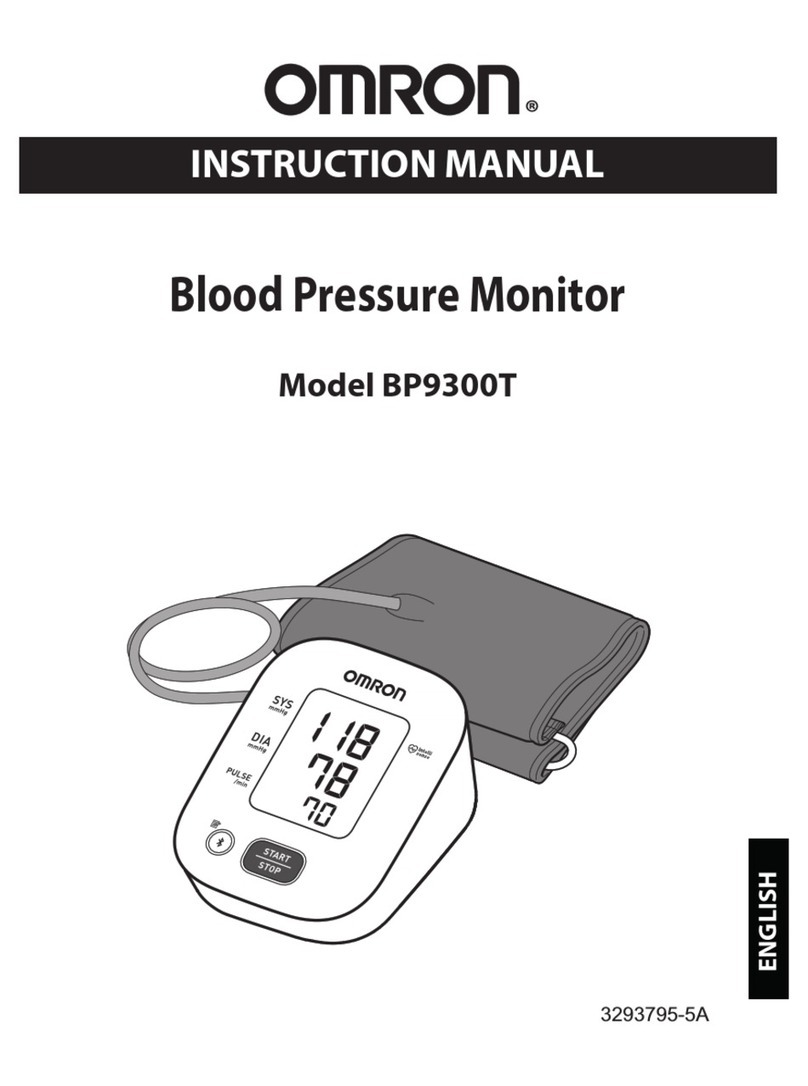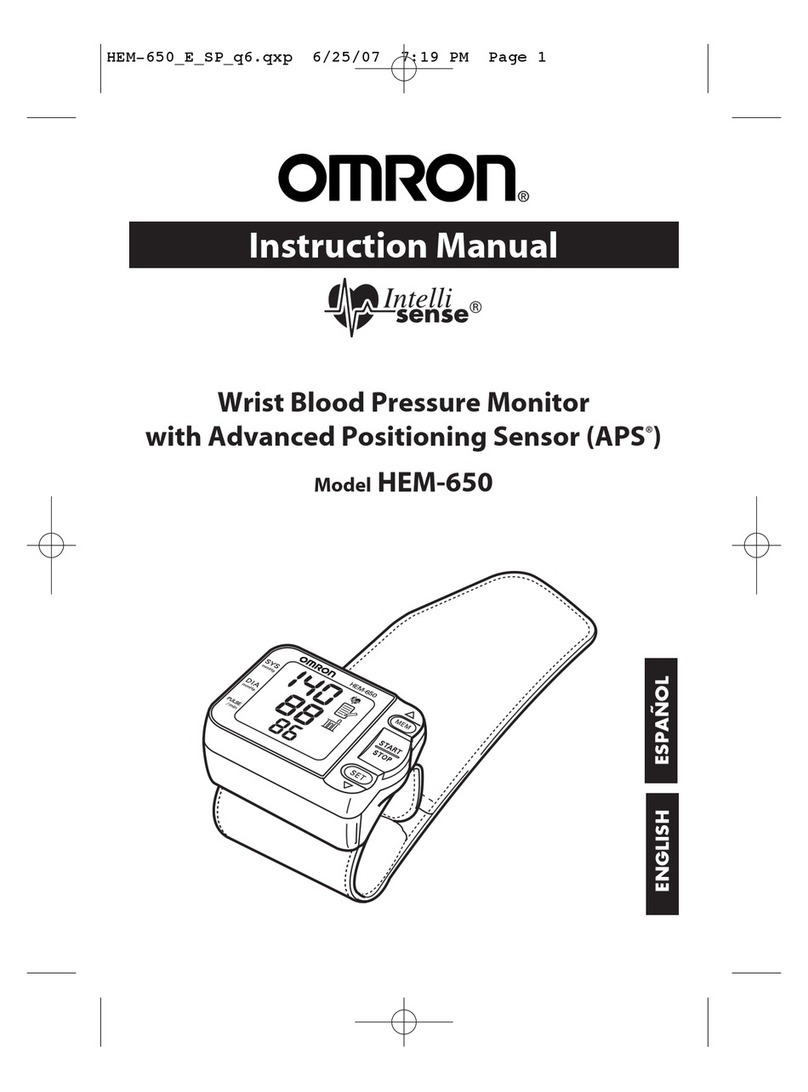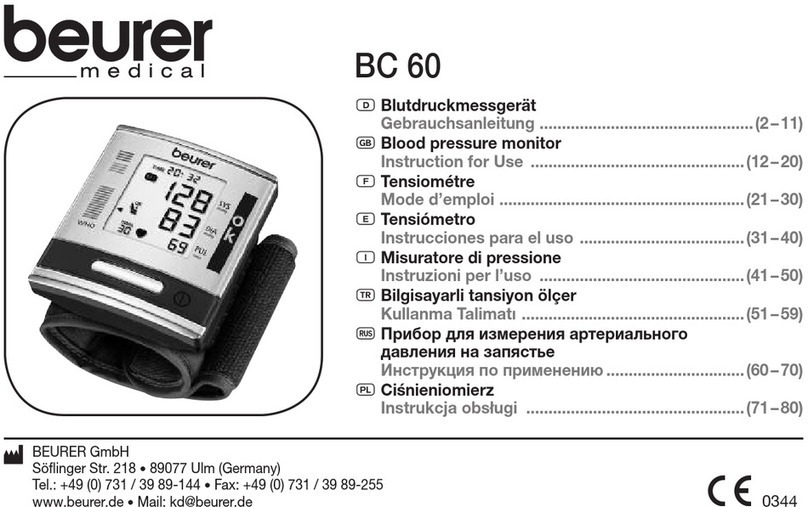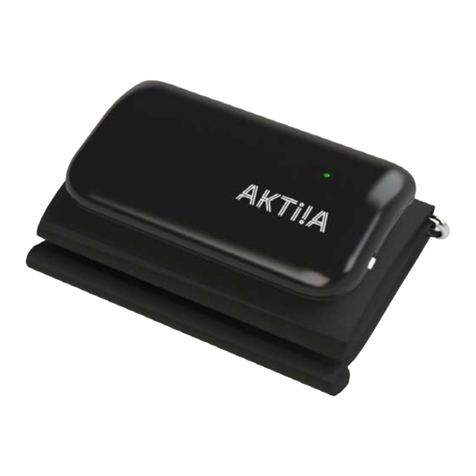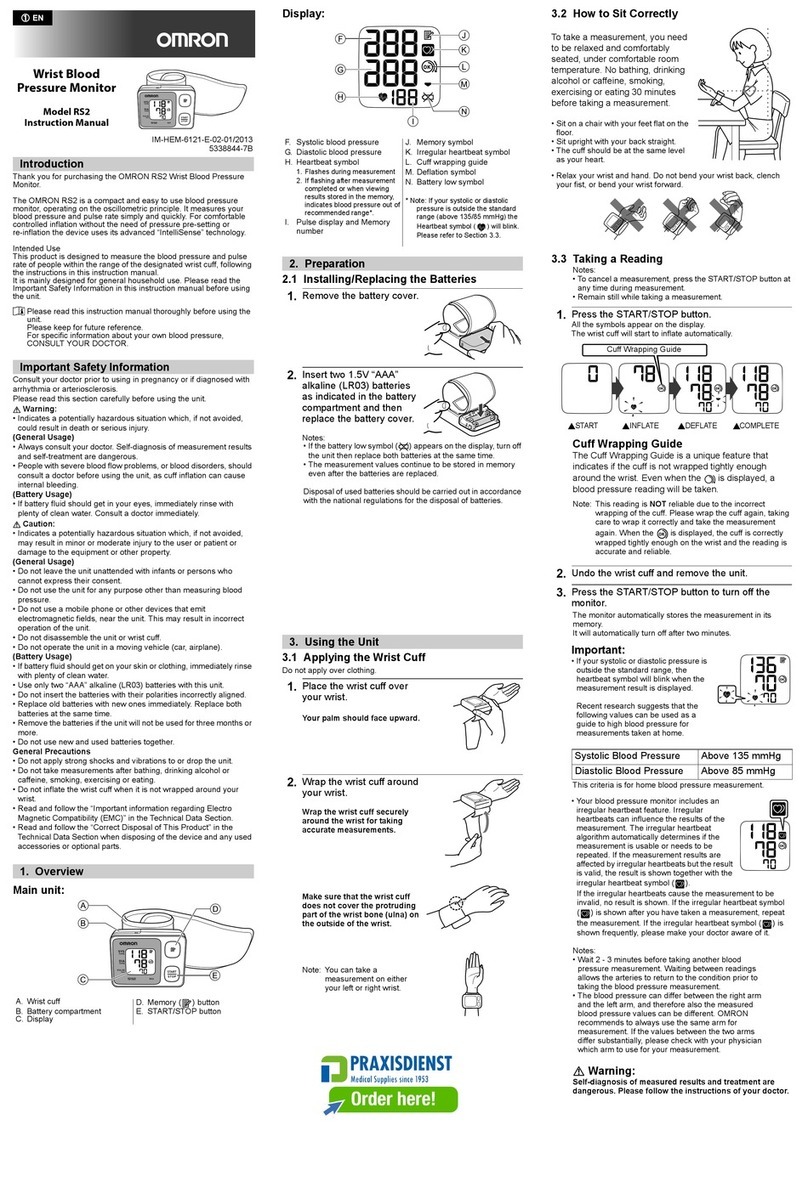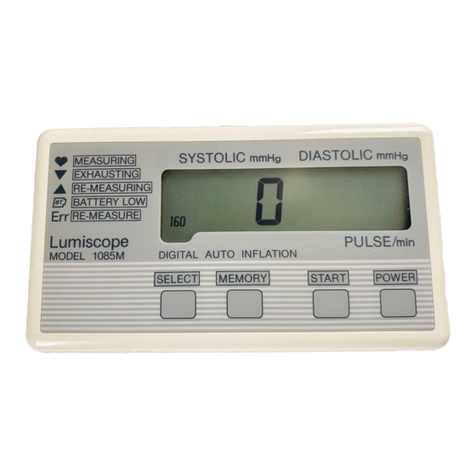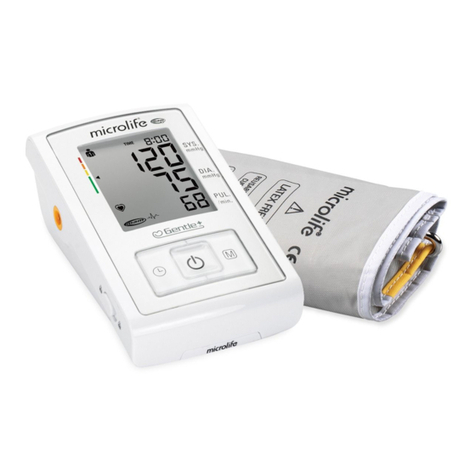Techmed TMA-6000 User manual

Template version:11/15
MODEL TMA-6000
Fully Automatic Arm Cuff Blood Pressure Monitor
(ELECTRONIC SPHYGMOMANOMETER)
OPERATION GUIDE
__________________________________________________________________________
INDEX
IMPORTANT INFORMATION .........................................................................2
CONTENTS AND DISPLAY INDICATORS.....................................................2
INTENDED USE ..............................................................................................3
CONTRAINDICATION.....................................................................................3
PRODUCT DESCRIPTION.............................................................................. 3
SPECIFICATIONS........................................................................................... 3
NOTICE ...........................................................................................................4
SETUP AND OPERATING PROCEDURES.................................................... 5
1. BATTERY LOADING .................................................................................. 5
2. CLOCK AND DATE ADJUSTMENT ...........................................................6
3. CONNECTING THE CUFF TO THE MONITOR ..........................................6
4. APPLYING THE CUFF................................................................................7
5. BODY POSTURE DURING MEASUREMENT ............................................7
6. TAKING YOUR BLOOD PRESSURE READING........................................ 8
7. DISPLAYING STORED RESULTS .............................................................8
8. DELETING MEASUREMENTS FROM THE MEMORY............................... 8
9. ASSESSING HIGH BLOOD PRESSURE FOR ADULTS ...........................9
10. TROUBLESHOOTING (1) .........................................................................9
11. TROUBLESHOOTING (2) .......................................................................10
MAINTENANCE ............................................................................................ 11
EXPLANATION OF SYMBOLS ON UNIT..................................................... 11
WARRANTY INFORMATION........................................................................ 12
SERVICE CENTER ....................................................................................... 12
ELECTROMAGNETIC COMPATIBILITY INFORMATION............................ 12

Template version:12/15
IMPORTANT INFORMATION
NORMAL BLOOD PRESSURE FLUCTUATION
All physical activity, excitement, stress, eating, drinking, smoking, body posture and many
other activities or factors (including taking a blood pressure measurement) will influence blood
pressure value. Because of this, it is mostly unusual to obtain identical multiple blood pressure
readings.
Blood pressure fluctuates continually ----- day and night. The highest value usually appears in
the daytime and lowest one usually at midnight. Typically, the value begins to increase at
around 3:00AM, and reaches to highest level in the daytime while most people are awake and
active.
Considering the above information, it is recommended that you measure your blood pressure
at approximately the same time each day.
Too frequent measurements may cause injury due to blood flow interference, please always
relax a minimum of 1 to 1.5 minutes between measurements to allow the blood circulation in
your arm to recover. It is rare that you obtain identical blood pressure readings each time.
CONTENTS AND DISPLAY INDICATORS

Template version:13/15
INTENDED USE
Fully Automatic Electronic Sphygmomanometer is for use by medical professionals or at home
and is a non-invasive blood pressure measurement system intended to measure the diastolic
and systolic blood pressures and pulse rate of an adult individual by using a non-invasive
technique in which an inflatable cuff is wrapped around the upper arm. The cuff circumference
is limited to 22cm-48cm(approx. 8 21/32″~18 29/32″).
CONTRAINDICATION
It is inappropriate for people with serious arrhythmia to use this Electronic
Sphygmomanometer.
PRODUCT DESCRIPTION
Based on Oscillometric methodology and silicon integrated pressure sensor, blood pressure
and pulse rate can be measured automatically and non-invasively. The LCD display will show
blood pressure and pulse rate.The most recent 60 measurements can be stored in the
memory with date and time stamp.The Electronic Sphygmomanometers corresponds to the
below standards: IEC 60601-1:2005/EN 60601-1:2006/AC:2010 (Medical electrical equipment
-- Part 1: General requirements for basic safety and essential performance),
IEC60601-1-2:2007/EN 60601-1-2:2007 /AC:2010 (Medical electrical equipment -- Part 1-2:
General requirements for basic safety and essential performance - Collateral standard:
Electromagnetic compatibility - Requirements and tests), EN 1060-1: 1995 + A1: 2002 + A2:
2009 (Non-invasive sphygmomanometers - Part 1: General requirements), EN 1060-3: 1997 +
A1: 2005 + A2: 2009 (Non-invasive sphygmomanometers - Part 3: Supplementary
requirements for electro-mechanical blood pressure measuring systems).
SPECIFICATIONS
1. Product name: Blood Pressure Monitor
2. Model: TMA-6000
3. Classification: Internally powered, Type BF applied part,IPX0,No AP or APG,Continuous
operation
4. Machine size: Approx. 154mm×104mm×45mm (6 1/16” x 4 3/32” x 1 25/32”)
5. Cuff circumference: 22cm-30cm(8 21/32″-11 13/16″), 30cm-42cm(11 13/16″-16 17/32
″) (Optional), 42cm-48cm(16 17/32″-18 29/32″) (Optional)
6. Weight: Approx. 234g (8 1/4oz.) (exclude batteries)
7. Measuring method: Oscillometric method, automatic inflation and measurement
8. Memory volume: 60 times with time and date stamp
9. Power source: DC 6V 600mA, batteries: 4 ×1.5V SIZE AA
10. Measurement range:
Cuff pressure: 0-300mmHg
Systolic: 60-260mmHg

Template version:14/15
Diastolic: 40-199mmHg
Pulse rate: 40-180 beats/minute
11. Accuracy:
Pressure: ±3mmHg
Pulse rate: ±5%
12. Environmental temperature for operation: 5℃~40℃(41℉~104℉)
13. Environmental humidity for operation: ≤90%RH
14. Environmental temperature for storage and transport: -20℃~55℃(-4℉~131℉)
15. Environmental humidity for storage and transport: ≤90%RH
16. Environmental pressure: 80kPa-105kPa
17. Battery life: Approx 360 times.
18. All components belonging to the pressure measuring system, including accessories:
Pump,Valve, LCD, Cuff, Sensor
Note: These specifications are subject to change without notice.
NOTICE
1. Read all of the information in the operation guide and any other literature in the box before
operating the unit.
2. Stay still, calm and rest for 5 minutes before blood pressure measurement.
3. The cuff should be placed at the same level as your heart.
4. During measurement, neither speak nor move your body and arm.
5. Measuring on same arm for each measurement.
6. Please always relax at least 1 or 1.5 minutes between measurements to allow the blood
circulation in your arm to recover. Prolonged over-inflation (cuff pressure exceed 300
mmHg or maintained above15 mmHg for longer than 3 minutes) of the bladder may cause
ecchymoma of your arm.
7. Consult your physician if you have any doubt about below cases:
1) The application of the cuff over a wound or inflammation diseases;
2) The application of the cuff on any limb where intravascular access or therapy, or an
arterio-venous (A-V) shunt, is present;
3) The application of the cuff on the arm on the side of a mastectomy;
4) Simultaneously used with other monitoring medical equipments on the same limb;
5) Need to check the blood circulation of the user.
8. This Electronic Sphygmomanometers is designed for adults and should never be
used on infants or young children. Consult your physician or other health care
professionals before use on older children.
9. Do not use this unit in a moving vehicle, This may result in erroneous measurement.
10. Blood pressure measurements determined by this monitor are equivalent to those
obtained by a trained observer using the cuff/stethoscope auscultation method, within the
limits prescribed by the American National Standard Institute, Electronic or automated
sphygmomanometers.

Template version:15/15
11. Information regarding potential electromagnetic or other interference between the blood
pressure monitor and other devices together with advice regarding avoidance of such
interference please see part ELECTROMAGNETIC COMPATIBILITY INFORMATION.
12. If Irregular Heartbeat (IHB) brought by common arrhythmias is detected in the procedure
of blood pressure measurement, a signal of will be displayed. Under this condition,
the Electronic Sphygmomanometers can keep function, but the results may not be
accurate, it’s suggested that you consult with your physician for accurate assessment.
There are 2 conditions under which the signal of IHB will be displayed:
1) The coefficient of variation (CV) of pulse period >25%.
2) The difference of adjacent pulse period≥0.14s, and the number of such pulse takes
more than 53 percentage of the total number of pulse.
13. Please do not use the cuff other than supplied by the manufacturer, otherwise it may bring
biocompatible hazard and might result in measurement error.
14. The monitor might not meet its performance specifications or cause safety hazard if
stored or used outside the specified temperature and humidity ranges in specifications.
15. Please do not share the cuff with other infective person to avoid cross-infection.
16. Medical AC adapter which output is DC 6.0V 600mA and complied with IEC 60601-1/EN
60601-1/UL 60601-1 and IEC 60601-1-2/EN 60601-1-2/UL 60601-1-2 is suitable for this
monitor. Please note that the monitor jack size: hole Φ3.5mm, center pin Φ1.0mm. Please
pay attention to polarity.
17. This equipment has been tested and found to comply with the limits for a Class B digital
device, pursuant to part 15 of the FCC Rules. These limits are designed to provide
reasonable protection against harmful interference in a residential installation. This
equipment generates, uses and can radiate radio frequency energy and, if not installed
and used in accordance with the instructions, may cause harmful interference to radio
communications. However, there is no guarantee that interference will not occur in a
particular installation. If this equipment does cause harmful interference to radio or
television reception, which can be determined by turning the equipment off and on, the
user is encouraged to try to correct the interference by one or more of the following
measures:
—Reorient or relocate the receiving antenna.
—Increase the separation between the equipment and receiver.
—Connect the equipment into an outlet on a circuit different from that to which the
receiver is connected.
—Consult the dealer or an experienced radio/TV technician for help.
SETUP AND OPERATING PROCEDURES
1. BATTERY LOADING
a. Open battery cover at the back of the monitor.
b. Load four “AA” size batteries. Please pay attention to polarity.
c. Close the battery cover.
When LCD shows battery symbol , replace all batteries with new ones.

Template version:16/15
Rechargeable batteries are not suitable for this monitor.
Remove the batteries if the monitor will not be used for a month or more to avoid relevant
damage of battery leakage.
Avoid the battery fluid to get in your eyes. If it should get in your eyes, immediately
rinse with plenty of clean water and contact a physician.
The monitor, the batteries and the cuff, must be disposed of according to local
regulations at the end of their usage.
2. CLOCK AND DATE ADJUSTMENT
a. Once you install the battery or turn off the monitor, it will enter Clock Mode, and
LCD will display time and date.
b. While the monitor is in Clock Mode, press the “START” and “MEM” button
simultaneously for two seconds, the month will blink at first. Press the button
“START” repeatedly, the day, hour and minute will blink in turn. While the number
is blinking, press the button “MEM” to increase the number. Keep on pressing the
button "MEM", the number will increase fast.
c. You can turn off the monitor by pressing “START” button when the minute is
blinking, then the time and date is confirmed.
d. The monitor will turn off automatically after 1 minute of no operation with the time
and date unchanged.
e. Once you change the batteries, you should readjust the time and date.
3. CONNECTING THE CUFF TO THE MONITOR
Insert the cuff tubing connector into the socket in the left side of the monitor. Make
certain that the connector is completely inserted to avoid air leakage during blood pressure
measurements.

Template version:17/15
Avoid compression or restriction of the connection tubing during measurement,
which may cause inflation error, or harmful injury due to continuous cuff pressure.
4. APPLYING THE CUFF
a. Pulling the cuff end through the medal loop (the cuff is
packaged like this already), turn it outward (away from your
body) and tighten it and close the Velcro fastener.
b. Place the cuff around a bare arm 1-2cm above the elbow joint.
c. While seated, place palm upside in front of you on a flat surface
such as a desk or table. Position the air tube in the middle of
your arm in line with your middle finger.
d. The cuff should fit comfortably, yet snugly around your arm.
You should be able to insert one finger between your arm and the cuff.
Note:
1. Please refer to the cuff circumference range in “SPECIFICATIONS” to make
sure that the appropriate cuff is used.
2. Measuring on same arm each time.
3. Do not move your arm, body, or the monitor and do not move the rubber tube
during measurement.
4. Stay quiet, calm for 5 minutes before blood pressure measurement.
5. Please keep the cuff clean. If the cuff becomes dirty, remove it from the monitor
and clear it by hand in a mild detergent, then rinse it thoroughly in cold water.
Never dry the cuff in clothes dryer or iron it. Clean the cuff after the usage of
every 200 times is recommended.
5. BODY POSTURE DURING MEASUREMENT
Sitting Comfortably Measurement
a. Be seated with your feet flat on the floor, and don’t cross your
legs.
b. Place palm upside in front of you on a flat surface such as a
desk or table.
c. The middle of the cuff should be at the level of the right atrium of the heart.
Lying Down Measurement
a. Lie on your back.
b. Place your arm straight along your side with your palm
upside.
c. The cuff should be placed at the same level as your
heart.

Template version:18/15
6. TAKING YOUR BLOOD PRESSURE READING
a. After applying the cuff and your body is in a comfortable
position, press the “START” button. A beep is heard and all
display characters are shown for self-test. You can check the
LCD display according to the right picture. Please contact the
service center if segment is missing.
b. If the monitor has stored results, the LCD will
momentarily display the most recent one. If no
result has been stored, zero will appear on LCD.
c. Then the monitor inflates the cuff until sufficient pressure has
built up for a measurement. Then the monitor slowly releases
air from the cuff and carries out the measurement. Finally the
blood pressure and pulse rate will be calculated and displayed
on the LCD screen. The blood pressure classification indicator
and Irregular heartbeat symbol (if any) will blink on the screen.
The result will be automatically stored in the monitor.
d. After measurement, the monitor will turn off automatically after 1 minute of no
operation. Alternatively, you can press the “START” button to turn off the monitor
manually.
e. During measurement, you can press the “START” button to turn off the monitor
manually.
Note: Please consult a health care professional for interpretation of pressure measurements.
7. DISPLAYING STORED RESULTS
a. In Clock Mode, press “MEM” button, the last result
will be displayed with date and time. Irregular
heartbeat symbol (if any) and the indicator of blood
pressure classification will blink at the same time.
Press “MEM” button repeatedly to review the
results measured previously.
b. When displaying the stored results, the monitor will turn off automatically after 2
minutes of no operation. You can also press the button “START” to turn off the monitor
manually.
8. DELETING MEASUREMENTS FROM THE
MEMORY
When any result is displaying, keeping on pressing

Template version:19/15
button “MEM” for three seconds, all results will be deleted after three “beep”. Press the
button “MEM” or “START”, the monitor will turn off.
9. ASSESSING HIGH BLOOD PRESSURE FOR ADULTS
The following guidelines for assessing high blood pressure (without regard to age or gender)
have been established by the World Health Organization (WHO). Please note that other
factors (e.g. diabetes, obesity, smoking, etc.) need to be taken into consideration. Consult with
your physician for accurate assessment, and never change your treatment by yourself.
Note: It is not intended to provide a basis of any type of rush toward emergency
conditions/diagnosis based on the color scheme and that the color scheme is meant only to
discriminate between the different levels of blood pressure.
10. TROUBLESHOOTING (1)
PROBLEM POSSIBLE CAUSE SOLUTION
LCD Display shows
battery symbol Low Battery Change all the batteries
Arm or blood pressure
monitor was moved
during testing
Re-test taking care to not move your
arm or the blood pressure monitor
The cuff does not inflate
properly or pressure falls
quickly during testing
Make certain the rubber tube is fully
inserted into the blood pressure
monitor
LCD Display shows
“EE”
Irregular heartbeat
(arrhythmia)
It is inappropriate for people with
serious arrhythmia to use this blood
pressure monitor.

Template version:110/15
11. TROUBLESHOOTING (2)
PROBLEM POSSIBLE CAUSE SOLUTION
LCD Display shows
“EE”
The cuff was not properly
applied or the rubber
tube was bent or
pressed.
Review the cuff applying and testing
sections of the instructions and
re-test.
The cuff position was not
correct or it was not
properly tightened
Apply the cuff correctly and try again
Body posture was not
correct during testing
Review the body posture and testing
sections of the instructions and
re-test.
LCD Display shows
abnormal result
Speaking, arm or body
movement, angry,
excited or nervous during
testing
Re-test when calm and without
speaking or moving during the test
No response when you
press button or load
battery
Incorrect operation, or
strong electromagnetic
interference
Take out batteries for five minutes,
and then reinstall all batteries.

Template version:111/15
MAINTENANCE
1. Do not drop this monitor or subject it to strong impact.
2. Avoid high temperature and solarization. Do not immerse the monitor in water as this
will result in damage to the monitor.
3. If this monitor is stored near freezing, allow it to acclimate to room temperature before
use.
4. Do not attempt to disassemble this monitor.
5. If you do not use the monitor for a long time, please remove the batteries.
6. It is recommended the performance should be checked every 2 years or after repair.
Please contact the service center.
7. Clean the monitor with a dry, soft cloth or a soft cloth squeezed well after moistened with
water, diluted disinfectant alcohol, or diluted detergent.
8. No component can be maintained by user in the monitor. The circuit diagrams,
component part lists, descriptions, calibration instructions, or other information which will
assist the user’s appropriately qualified technical personnel to repair those parts of
equipment which are designated repairably can be supplied.
9. The monitor can maintain the safety and performance characteristics for a minimum of
10,000 measurements or three years, and the cuff integrity is maintained after 1,000
open–close cycles of the closure.
10. It is recommended the cuff should be disinfected 2 times every week if needed (For
example, in hospital or in clinique). Wipe the inner side (the side contacts skin) of the cuff
by a soft cloth squeezed after moistened with Ethyl alcohol (75-90%), then dry the cuff by
airing.
EXPLANATION OF SYMBOLS ON UNIT
Symbol for” THE OPERATION GUIDE MUST BE READ”(The sign background colour:
blue.The sign graphical symbol: white)
Symbol for “WARNING”
Symbol for “TYPE BF APPLIED PARTS” (The cuff is type BF applied part)
Symbol for “ENVIRONMENT PROTECTION – Waste electrical products should not be
disposed of with household waste. Please recycle where facilities exist. Check with your local
Authority or retailer for recycling advice”.
Symbol for “MANUFACTURER”
Symbol for “COMPILES WITH MDD93/42/EEC REQUIREMENTS”
Symbol for “DATE OF MANUFACTURE”

Template version:112/15
EC REP
Symbol for “EUROPEAN REPRESENTATION”
Symbol for “Polarity of d.c. power connector”
SN Symbol for “SERIAL NUMBER”
Symbol for “KEEP DRY”
WARRANTY INFORMATION
Only charge the cost of components and transport.
SERVICE CENTER
ANDON HEALTH CO., LTD.
No. 3 Jinping Street, YaAn Road, Nankai District, Tianjin 300190, China.
Tel: 86-22-60526081
Lotus Global Co., Ltd.
1 Four Seasons Terrace West Drayton, Middlesex, London, UB7 9GG,United
Kingdom
Tel: +0044-20-75868010 Fax: +0044-20-79006187
ELECTROMAGNETIC COMPATIBILITY INFORMATION
Table 1
For all ME EQUIPMENT and ME SYSTEMS
Guidance and manufacture’s declaration - electromagnetic emissions
The TMA-6000 is intended for use in the electromagnetic environment specified below.
The customer or the user of the TMA-6000 should assure that it is used in such an
environment.
Emissions test Compliance Electromagnetic environment -
guidance
RF emissions
CISPR 11 Group 1
The TMA-6000 uses RF energy only for its
internal function. Therefore, its RF
emissions are very low and are not likely
to cause any interference in nearby
electronic equipment.
RF emissions
CISPR 11 Class B
Harmonic emissions
IEC 61000-3-2 Not applicable
Voltage fluctuations/
flicker emissions
IEC 61000-3-3
Not applicable
The TMA-6000 is suitable for use in all
establishments other than domestic and
those directly connected to the public
low-voltage power supply network that
supplies buildings used for domestic
purposes.
EC REP

Template version:113/15
Table 2
For all ME EQUIPMENT and ME SYSTEMS
Guidance and manufacturer’s declaration - electromagnetic immunity
The TMA-6000 is intended for use in the electromagnetic environment specified below. The
customer or the user of the TMA-6000 should assure that it is used in such an environment.
IMMUNITY test IEC 60601test level Compliance level
Electromagnetic
environment -
guidance
Electrostatic
discharge (ESD)
IEC 61000-4-2
± 6 kV contact
± 8 kV air
± 6 kV contact
± 8 kV air
Floors should be
wood, concrete
or ceramic tile. If
floors are
covered with
synthetic
material, the
relative humidity
should be at least
30 %.
Power frequency
(50/60 Hz)
magnetic field
IEC 61000-4-8
3 A/m 3 A/m Power frequency
magnetic fields
should be at
levels
characteristic of a
typical location in
a typical
commercial or
hospital
environment.
Table 3
For ME EQUIPMENT and ME SYSTEMS that are not LIFE-SUPPORTING
Guidance and manufacturer’s declaration - electromagnetic immunity
The TMA-6000 is intended for use in the electromagnetic environment specified below. The
customer or the user of the TMA-6000 should assure that it is used in such an environment.
IMMUNITY test IEC 60601test level Compliance
level
Electromagnetic environment
- guidance
Portable and mobile RF
communications equipment
should be used no closer to any
part of the TMA-6000, including
cables, than the recommended
separation distance calculated
from the equation applicable to
the frequency of the transmitter.

Template version:114/15
Radiated RF
IEC 61000-4-3
3 V/m 80 MHz to 2.5
GHz
3 V/m
Recommended separation
distance:
80 MHz to 800
MHz
800 MHz to 2,5
GHz
Where P is the maximum output
power rating of the transmitter
in watts (W) according to the
transmitter manufacturer and d
is the recommended separation
distance in meters (m).
Field strengths from fixed RF
transmitters, as determined by
an electromagnetic site survey,a
should be less than the
compliance level in each
frequency range.b
Interference may occur in the
vicinity of equipment
marked with the following
symbol:
NOTE 1 At 80 MHz and 800 MHz, the higher frequency range applies.
NOTE 2 These guidelines may not apply in all situations. Electromagnetic propagation is
affected by absorption and reflection from structures, objects and people.
a Field strengths from fixed transmitters, such as base stations for radio (cellular/cordless)
telephones and land mobile radios, amateur radio, AM and FM radio broadcast and TV
broadcast cannot be predicted theoretically with accuracy. To assess the electromagnetic
environment due to fixed RF transmitters, an electromagnetic site survey should be
considered. If the measured field strength in the location in which the TMA-6000 is used
exceeds the applicable RF compliance level above, the TMA-6000 should be observed to
verify normal operation. If abnormal performance is observed, additional measures may be
necessary, such as re-orienting or relocating the TMA-6000.
b Over the frequency range 150 kHz to 80 MHz, field strengths should be less than 3 V/m.
Table 4
Pd 2.1=
Pd 3.2=

Template version:115/15
For ME EQUIPMENT and ME SYSTEMS that are not LIFE-SUPPORTING
Recommended separation distances between
portable and mobile RF communications equipment and the TMA-6000
The TMA-6000 is intended for use in an electromagnetic environment in which radiated RF
disturbances are controlled. The customer or the user of the TMA-6000 can help prevent
electromagnetic interference by maintaining a minimum distance between portable and
mobile RF communications equipment (transmitters) and the TMA-6000 as recommended
below, according to the maximum output power of the communications equipment.
Separation distance according to frequency of transmitter
m
Rated maximum
output
power of
transmitter
W
150 kHz to 80 MHz
80 MHz to 800 MHz
800 MHz to 2,5 GHz
0,01 0.12 0.12 0.23
0,1 0.38 0.38 0.73
1 1.2 1.2 2.3
10 3.8 3.8 7.3
100 12 12 23
For transmitters rated at a maximum output power not listed above, the recommended
separation distance d in meters (m) can be determined using the equation applicable to the
frequency of the transmitter, where P is the maximum output power rating of the transmitter
in watts (W) according to the transmitter manufacturer.
NOTE 1 At 80 MHz and 800 MHz, the separation distance for the higher frequency range
applies.
NOTE 2 These guidelines may not apply in all situations. Electromagnetic propagation is
affected by absorption and reflection from structures, objects and people.
Pd 2.1=Pd 2.1=Pd 3.2=
Table of contents
Other Techmed Blood Pressure Monitor manuals
